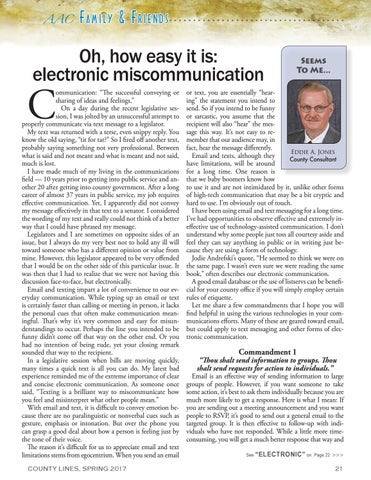AAC
Family & Friends
» » » » » » » » » » » » » » » » » » » » » » » » » » » » » » » » » » » » »
Oh, how easy it is: electronic miscommunication
C
ommunication: “The successful conveying or sharing of ideas and feelings.” On a day during the recent legislative session, I was jolted by an unsuccessful attempt to properly communicate via text message to a legislator. My text was returned with a terse, even snippy reply. You know the old saying, “tit for tat?” So I fired off another text, probably saying something not very professional. Between what is said and not meant and what is meant and not said, much is lost. I have made much of my living in the communications field — 10 years prior to getting into public service and another 20 after getting into county government. After a long career of almost 37 years in public service, my job requires effective communication. Yet, I apparently did not convey my message effectively in that text to a senator. I considered the wording of my text and really could not think of a better way that I could have phrased my message. Legislators and I are sometimes on opposite sides of an issue, but I always do my very best not to hold any ill will toward someone who has a different opinion or value from mine. However, this legislator appeared to be very offended that I would be on the other side of this particular issue. It was then that I had to realize that we were not having this discussion face-to-face, but electronically. Email and texting impart a lot of convenience to our everyday communication. While typing up an email or text is certainly faster than calling or meeting in person, it lacks the personal cues that often make communication meaningful. That’s why it’s very common and easy for misunderstandings to occur. Perhaps the line you intended to be funny didn’t come off that way on the other end. Or you had no intention of being rude, yet your closing remark sounded that way to the recipient. In a legislative session when bills are moving quickly, many times a quick text is all you can do. My latest bad experience reminded me of the extreme importance of clear and concise electronic communication. As someone once said, “Texting is a brilliant way to miscommunicate how you feel and misinterpret what other people mean.” With email and text, it is difficult to convey emotion because there are no paralinguistic or nonverbal cues such as gesture, emphasis or intonation. But over the phone you can grasp a good deal about how a person is feeling just by the tone of their voice. The reason it’s difficult for us to appreciate email and text limitations stems from egocentrism. When you send an email COUNTY LINES, SPRING 2017
Seems To Me...
or text, you are essentially “hearing” the statement you intend to send. So if you intend to be funny or sarcastic, you assume that the recipient will also “hear” the message this way. It’s not easy to remember that our audience may, in fact, hear the message differently. Eddie A. Jones Email and texts, although they County Consultant have limitations, will be around for a long time. One reason is that we baby boomers know how to use it and are not intimidated by it, unlike other forms of high-tech communication that may be a bit cryptic and hard to use. I’m obviously out of touch. I have been using email and text messaging for a long time. I’ve had opportunities to observe effective and extremely ineffective use of technology-assisted communication. I don’t understand why some people just toss all courtesy aside and feel they can say anything in public or in writing just because they are using a form of technology. Jodie Andrefski’s quote, “He seemed to think we were on the same page. I wasn’t even sure we were reading the same book,” often describes our electronic communication. A good email database or the use of listservs can be beneficial for your county office if you will simply employ certain rules of etiquette. Let me share a few commandments that I hope you will find helpful in using the various technologies in your communications efforts. Many of these are geared toward email, but could apply to text messaging and other forms of electronic communication.
Commandment 1
“Thou shalt send information to groups. Thou shalt send requests for action to individuals.”
Email is an effective way of sending information to large groups of people. However, if you want someone to take some action, it’s best to ask them individually because you are much more likely to get a response. Here is what I mean: If you are sending out a meeting announcement and you want people to RSVP, it’s good to send out a general email to the targeted group. It is then effective to follow-up with individuals who have not responded. While a little more timeconsuming, you will get a much better response that way and See
“ELECTRONIC” on
Page 22
>>>
21





